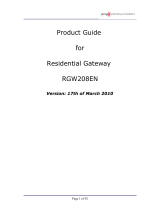
6 of 72
MTU: The Maximum Transmission Unit (MTU) is a parameter that determines the largest
packet size (in bytes) that the router will send to the WAN. If LAN devices send larger
packets, the router will break them into smaller packets. Ideally, you should set this to
match the MTU of the connection to your ISP. Typical values are 1500 bytes for an
Ethernet connection and 1492 bytes for a PPPoE connection. If the router's MTU is set
too high, packets will be fragmented downstream. If the router's MTU is set too low, the
router will fragment packets unnecessarily and in extreme cases may be unable to
establish some connections. In either case, network performance can suffer.
MAC Address: Each networking device has it's own unique MAC address defined by the
hardware manufacturer. Some ISP's may check your computer's MAC address. Some
ISP's record the MAC address of the network adapter in the computer or router used to
initially connect to their service. The ISP will then only grant Internet access to requests
from a computer or router with this particular MAC address. This router has a different
MAC address than the computer or router that initially connected to the ISP. If you need
to change the MAC address of the rounter's WAN-side Ethernet interface, either type in
an alternate MAC address (for example, the MAC address of the router initially connected
to the ISP) or copy the MAC address of a PC. To copy the MAC address of the computer
that initially connected to the ISP, connect to the router using that computer and click the
Clone Your PC's MAC Address button. The WAN interface will then use the MAC
address of the network adapter in your computer.
NETWORK
Router Settings
These are the settings of the LAN (Local Area Network) interface for the router. The
router's local network (LAN) settings are configured based on the IP Address and Subnet
Mask assigned in this section. The IP address is also used to access this Web-based
management interface. It is recommended that you use the default settings if you do not
have an existing network.
IP Address
The IP address of your router on the local area network. Your local area network settings
are based on the address assigned here. For example, 192.168.0.1.
Subnet Mask
The subnet mask of your router on the local area network.
Local Domain Name
This entry is optional. Enter a domain name for the local network. LAN computers will
assume this domain name when they get an address from the router's built in DHCP
server. So, for example, if you enter mynetwork.net here, and you have a LAN side
laptop with a name of chris, that laptop will be known as chris.mynetwork.net. Note,
however, the entered domain name can be overridden by the one obtained from the
router's upstream DHCP server.




















